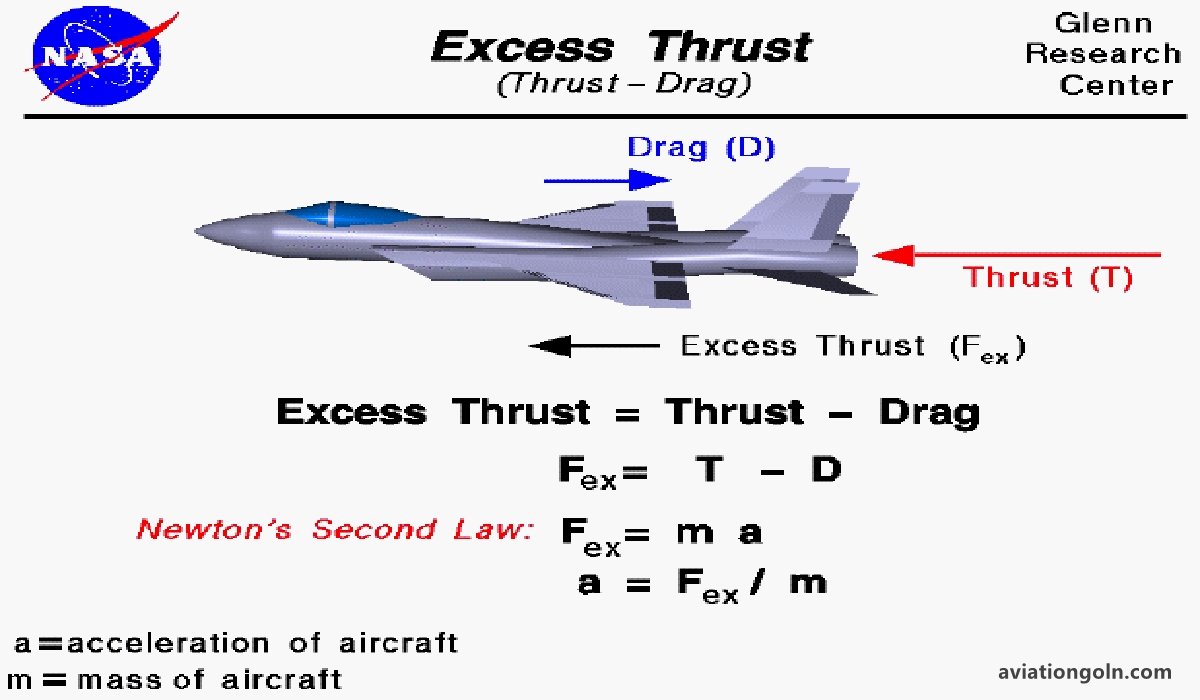Thrust and Power: For an aircraft to stay airborne, it requires a balance of various forces. Of these forces, thrust plays a crucial role. It propels the aircraft forward, counteracting the drag created by the aircraft’s motion and allowing it to achieve and maintain flight. This article delves into the intricacies of thrust and power, detailing their importance in determining an aircraft’s performance.
Thrust and Power: Aircraft Performance
1. Basics of Aircraft Forces
Before diving into thrust and power, it’s essential to have a grasp of the fundamental forces acting on an aircraft during flight:
- Lift: Generated primarily by the wings, it opposes the weight and keeps the aircraft aloft.
- Weight (or Gravity): It pulls the aircraft downward towards the earth’s center.
- Thrust: Produced by the aircraft’s propulsion system, it moves the aircraft forward.
- Drag: The aerodynamic resistance faced by the aircraft as it moves through the air.
For steady, level flight, lift equals weight, and thrust equals drag.

2. Understanding Thrust
Thrust is the force generated by the aircraft’s engines, propelling it forward. It’s a reaction force described quantitatively by Newton’s Third Law. The engine expels gas at high speed in one direction, and an equal and opposite force (thrust) propels the aircraft in the opposite direction.
- Types of Engines and Thrust Production:
- Jet Engines: Work on the principle of taking in a large volume of air, compressing it, mixing it with fuel, igniting the mixture, and expelling it at high velocities to generate thrust.
- Propellers: They generate thrust by moving a large mass of air behind them, creating a high-speed flow that provides forward motion.

3. The Power Equation
In aviation, power (P) is a measure of how much work the engine does over time. For propeller-driven aircraft, the power equation can be written as:
�=��
Where:
�is the power in watts (or horsepower in aviation terms),
�is the thrust in newtons, and
�is the velocity of the aircraft in meters per second.

This equation showcases the direct relationship between power, thrust, and velocity. In the case of jet engines, the concept is more complicated due to the higher velocities and temperatures involved, but the essence remains the same.
4. Aircraft Performance Metrics
Several factors determine the performance of an aircraft, many of which are directly or indirectly related to thrust and power:
- Rate of Climb: Determined by the excess power or thrust beyond what’s needed for level flight. The more excess power an aircraft has, the faster it can climb.
- Cruise Speed: The speed at which an aircraft can fly with optimal fuel efficiency. It’s a balance between engine power and the drag the aircraft experiences.
- Range: Dictated by fuel efficiency and fuel capacity, the maximum distance an aircraft can fly without refueling is its range. Better engine efficiency (more thrust and power with less fuel) generally translates to a longer range.

- Service Ceiling: The maximum altitude at which an aircraft can maintain a specified rate of climb, largely determined by the aircraft’s power and wing design.
- Takeoff and Landing Distances: Powerful engines that provide higher thrust will shorten the required takeoff distance. Conversely, efficient brakes and reverse thrust mechanisms can reduce landing distances.

5. Factors Influencing Thrust and Power
Several external and internal factors can influence the thrust and power produced by an aircraft engine:
- Altitude: As altitude increases, air density decreases. For propeller-driven aircraft, this means less air to “grab,” resulting in reduced thrust. Jet engines, which rely on oxygen to burn fuel, might also see decreased performance at high altitudes due to the reduced oxygen content.
- Temperature: Hotter air is less dense. On hot days, aircraft engines, particularly jet engines, might produce less thrust than on cooler days.
- Aircraft Design: The design of the air intake, the type of engine, and the exhaust mechanism can all influence the efficiency and thus the thrust and power generated.
- Engine Wear: Over time, engines can wear out or become less efficient due to accumulated debris, necessitating regular maintenance to ensure optimal performance.

6. The Interplay between Thrust and Drag
While thrust propels the aircraft forward, drag tries to hold it back. To achieve efficient flight, aircraft designers aim for the maximum thrust with the least drag. The balance between these forces determines the fuel efficiency and speed capabilities of the aircraft.
- Parasite vs. Induced Drag: Parasite drag is everything not associated with lift (like form drag and skin friction). Induced drag relates to the creation of lift. At low speeds, induced drag is dominant, while at high speeds, parasite drag prevails.
- Thrust Required Curves: By plotting the thrust required against airspeed for different flight conditions, designers can identify optimal operating speeds and conditions for an aircraft.

7. Advancements in Thrust and Power Technology
With the relentless pursuit of efficiency, safety, and speed, the aviation industry continually innovates. Engine technologies, such as high-bypass turbofans, have become more prevalent due to their better fuel efficiency and reduced noise. Electric propulsion, while still in nascent stages, promises a future with reduced carbon emissions.

Thrust and power are fundamental to an aircraft’s ability to fly. By understanding how they interplay with other forces and by optimizing their production, the aviation industry has been able to create faster, safer, and more efficient machines. As technology advances, we can anticipate even greater improvements in aircraft performance, driven by the ongoing evolution of our understanding and manipulation of thrust and power.
See more:
